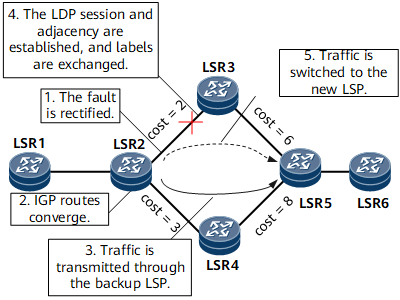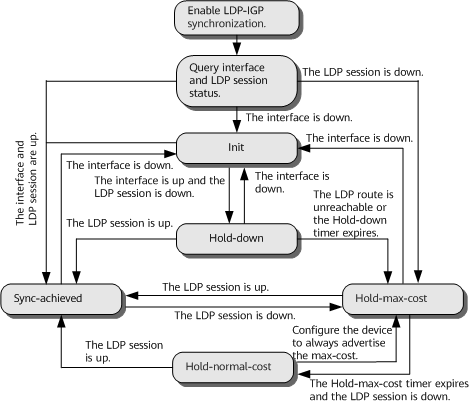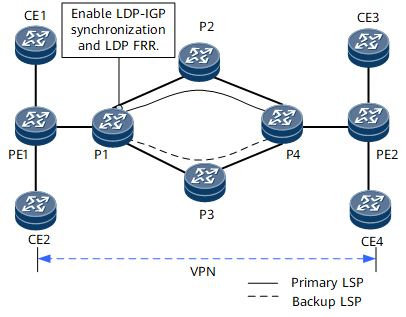LDP-IGP Synchronization
Background
LDP-IGP synchronization is used to synchronize the status between LDP and an IGP to minimize time of traffic loss if a network fault triggers the LDP and IGP switching.
On a network with primary and backup links, if the primary link fails, both IGP and LSP traffic switches to the backup link. After the primary link recovers, IGP routes are switched back to the primary link before LDP convergence is complete. In this case, the LSP along the primary link takes time to make preparations, such as adjacency restoration, before being established. As a result, LSP traffic is discarded. If an LDP session or adjacency between nodes fails on the primary link, the LSP along the primary link is deleted. However, the IGP still uses the primary link, and as a result, LSP traffic cannot be switched to the backup link, and is continuously discarded.

LDP-IGP synchronization supports OSPFv2 and IS-IS IPv4.
The fundamentals of LDP-IGP synchronization are to set an IGP cost value to delay a route switchback until LDP convergence is complete. That is, before the LSP of the primary link is established, the LSP of the backup link is retained so that the traffic continues to be forwarded through the backup link. The backup LSP is torn down only after the primary LSP is established successfully.
LDP-IGP synchronization involves the following timers:
Hold-max-cost timer
Delay timer
Implementation
- The network shown in Figure 1 has primary and backup links. When the primary link recovers from a fault, traffic is switched from the backup link back to the primary link. During the traffic switchback, if the backup LSP cannot be used after IGP convergence and the LSP of the primary link is not set up, the traffic is discarded. To prevent this problem, LDP-IGP synchronization can be configured to delay IGP route switchback until LDP convergence is complete. The backup LSP is not deleted and continues forwarding traffic until an LSP over the primary link is established. The detailed process is as follows:
A link recovers from a fault.
An LDP session is set up between LSR2 and LSR3. The IGP advertises the maximum cost of the primary link to delay the IGP route switchback.
Traffic is still forwarded along the backup LSP.
The LDP session is set up. Label messages are exchanged to notify the IGP to start synchronization.
The IGP advertises the normal cost on the primary link, and its routes converge on the original forwarding path. The LSP is reestablished and delivered to the forwarding table (usually in milliseconds).
- If an LDP session between two nodes on the primary link fails, the LSP on the primary link is deleted, but the IGP still uses the primary link. In this case, traffic fails to switch from the primary link to a backup link and is discarded. To prevent this problem, you can configure LDP-IGP synchronization. If an LDP session fails, LDP notifies the IGP of the failure. The IGP advertises the maximum cost of the failed link, which enables the route to switch from the primary link to the backup link. Then LSP switchover to the backup link is implemented. The detailed process is as follows:
An LDP session between two nodes on the primary link fails.
LDP notifies the IGP of the primary link failure. The IGP then advertises the maximum cost of the primary link.
The IGP route switches to the backup link.
A backup LSP is set up over the backup link and then forwarding entries are delivered.
LDP-IGP synchronization state transition
After LDP-IGP synchronization is enabled on an interface, the IGP queries the status of the interface and LDP session according to Figure 2, enters the corresponding state according to the query result, and then changes the state according to Figure 2. The preceding status varies according to the IGP.
The preceding status varies according to the IGP.- When OSPF is used as the IGP, the status transits based on the flowchart shown in Figure 2.
- When IS-IS is used as the IGP, the Hold-normal-cost state does not exist. After the Hold-max-cost timer expires, IS-IS advertises the actual link cost, but the Hold-max-cost state is displayed even though this state is nonexistent.
Usage Scenario
LDP-IGP synchronization mainly applies to the following scenario:
Benefits
Packet loss is reduced during an active/standby link switchover, improving network reliability.


